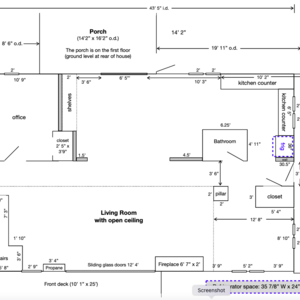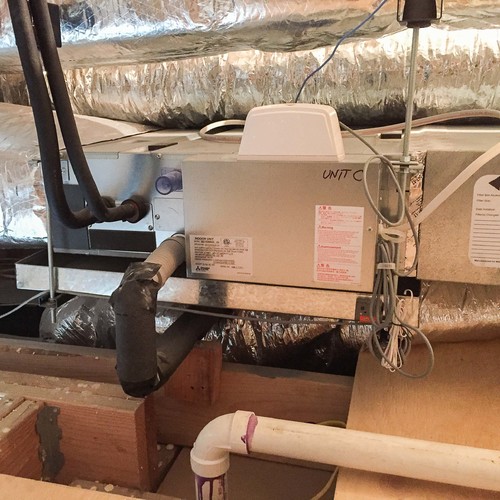
The unprecedented heat this summer has a lot of people feeling uncomfortable. One of them is Chief083, who writes in this recent Q&A post that the second floor of his 4000-sq.-ft. house near Washington, D.C., runs 10 degrees hotter than downstairs.
“The air flow to the second floor is not very good,” Chief writes. “I am leaning toward getting a minisplit for each bedroom upstairs—so at least four of them. Before I pull the trigger I wanted to know if adding a second HVAC unit to increase air flow to the existing vents for the second floor would be better.”
Although he’s read about the value of adding insulation, he still believes he ultimately will upgrade the HVAC system for increased comfort on the second floor. He’s looking for recommendations on the brand of minisplit he should buy.
Or is Chief barking up the wrong tree? That’s the question for this Q&A Spotlight.
Minisplits are not magic
DC Contrarian points out that no matter what the mechanical equipment might be, if it’s not sized correctly, it won’t make the house comfortable.
“There’s no magic to minisplits,” Contrarian says. “You have to go through the same sizing process. An improperly sized minisplit will not provide comfort. What’s not intuitive is that one that is too large is more of a problem than one that’s too small. One that’s too large won’t be able to hold temperature, it will be hot and cold, and it won’t dehumidify properly.”
The square footage of Chief’s house is irrelevant to how much heating and cooling he needs. To get those answers, Chief needs a Manual J calculation, which will establish heating and cooling loads based on such factors…
Weekly Newsletter
Get building science and energy efficiency advice, plus special offers, in your inbox.

This article is only available to GBA Prime Members
Sign up for a free trial and get instant access to this article as well as GBA’s complete library of premium articles and construction details.
Start Free TrialAlready a member? Log in















2 Comments
Big elephant in the room that nobody mentioned: That energy audit identified a lot of air leakage to/from the attic. In the summer, that heavier colder inside air sinks down (like an elephant) and sucks in hot air from the attic. That keeps the upstairs hot, humid, and uncomfortable.
I'd approach it in this order:
1. Adjust dampers in the ducts if available to send as much air as possible upstairs, and a little less downstairs. Just because this is quick and easy and might help comfort.
2. Air seal the attic penetrations. Recessed lights might be the chief culprits. LED trim caulked to the ceiling is one approach. Do all the air sealing you can, items listed and more, before,
3. Upgrade the attic insulation.
4. Improve the duct problems that are discussed above and in the original thread.
I like 2 and 3 best because they reduce the overall load, and thus save the most energy, as well as improving comfort.
Hello Chief,
As a "neighbor" in nearly-Washington DC with a house of the about the same size and same age (early 1980s), that has had those same extreme temperature stratification problems when I moved in, I would recommend a few things:
1) Fix the duct issues. That renovation that changed the ducts seemed like a really, really bad idea. I don't see much other option for you besides opening up the wall where the ducts are and then changing the cross sectional area to something larger to allow more air-flow. There are some houses in my neighborhood where the duct work layout is just awful - The duct diameters going to the 2nd floor are just very narrow relative to the volume of space up there, and they are way hot on the 2nd floor.
2) Air-seal, air-seal, air-seal. When I first moved into my home, I found holes ALL over the ceiling plane that were accessible to the indoor space: electrical penetration, attic access, and worse - duct boots (if that's where your ducts are). After sealing those up, I got braver and spent my free time over the better part of two years on my belly in the attic with a caulk gun, sealing drywall-to-top-plate gaps. If you want to preserve your free time, limit your bodily risk, and leave the work up to the professionals, such work in this area for your house size costs ~$3000 - $4000 including added insulation, and have the work completed in a day. I also added more insulation to the top of what I already had to achieve roughly an R-60, though such an amount is probably not necessary if you only have ~R-19 at the moment. R-49 is current code.
3) My ductwork in the basement where the Air Handler Unit is, has a couple dampers, so I seasonally adjust them by ~20% to send more cold air to the top floor in the summer, and warmer air to the bottom floor in the winter.
4) While I was up in the attic, I also removed the duct insulation, added mastic in spots and metal-backed acrylic adhesive tape (NOT DUCT TAPE) to the major seams, and sealed up the duct insulation again. It is possible to do things like Aerosealing which seals the ducts from the inside out without having to remove insulation. However, that will also set you back another couple thousand.
I am betting if you do these things that it'll cost you ~$10k-$12k. However, due to your desire for an "active" solution like to a minisplit(s) or zoning, I think you'd end up spend that much or more on another HVAC system. You'd likely have to upgrade your electrical panel in the process, pull new wires, and the like. Note, most HVAC contractors that you'd call will look at the value of your home and your "comfort issues" and read $$$$, so I could easily see you getting quotes for a 2nd system in the $15k+ range. And now you'd have two systems that you are responsible for maintaining, and the downstairs one will be oversized day 1. So I don't know that it makes a ton of sense to do a 2nd system.
I don't hear Chief talking about the upstairs being too cold in the winter. Only that it is too hot with a publish date of June 2021. Part of that is probably due to the furnace hot air rising and the higher infiltration rate providing some flow-boost from the 1st floor to the 2nd. I.e. the air that is provided to the bottom floor filters its way to the top floor due to natural convection and air leakage.
Lastly, depending on your home orientation and location near trees, typical solar panels provide partial shading to the roof and a naturally-vented exterior surface, thereby making the attic a few degrees cooler. It could make sense to take advantage of the 26% solar tax credit while it is around this year, to get renewable energy and take some of the edge off your attic temperatures. Of course, this would be an extra cost and the roof shading aspect would be a minor, secondary benefit of lesser value than air-sealing, insulating, ensuring adequate HVAC system flow.
Note, I have about a 4,000 square foot house too, front of my house faces South-Southwest, trees at the East and North (i.e. I'm in pretty full summer sun), my AC system is only 3 tons, and we seem to be doing well with summer comfort.
Best of luck!
Log in or become a member to post a comment.
Sign up Log in